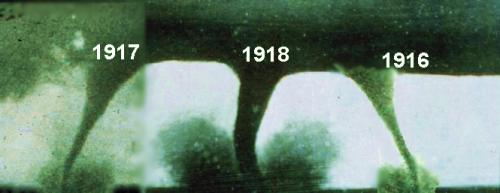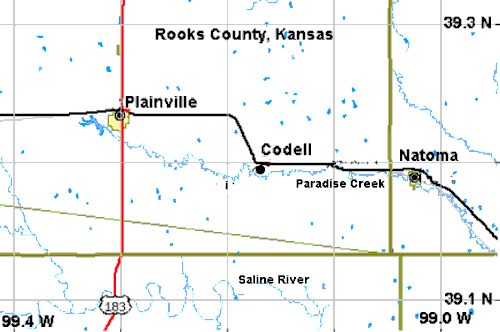 |
 |
| Home | Welcome | What's New | Site Map | Glossary | Weather Doctor Amazon Store | Book Store | Accolades | Email Us |
 | |||||||||
Weather Almanac for May 2006THREE STRIKES ON CODELLIt was a series of events that made the pages of Ripley's Believe It or Not and put the small Kansas community of Codell on the pages of most weather history books. And its odds were astronomical. If you don't know what events I am referring to, here are the basic facts.  On the 20th day of May in 1916, Codell, Kansas was hit by a tornado. Well, you say, that part of Kansas is in Tornado Alley, so it is not too surprising to hear that fact. True, but on the same day, in 1917 and again in 1918, Codell was struck by a tornado. Three strikes on a community in three years is news enough, but for them to occur on exactly the same date is, well, a story for Ripley's. Even more astounding, the storms hit around the same time on each day, between 6 and 9 pm. Settlers began arriving in Paradise Township of Rooks County in north-central Kansas between 1868 to 1878. The first town established was Motor, but when disputes with the Union Pacific Railroad over land reached a stalemate, the UP built their depot about a mile west and established a townsite it named Codell, meaning "retired glen," in 1888. Over the next two decades, the town grew and included a bank, hotel, restaurant, hardware store and two churches. Kansas is legendary for its tornadoes, in fact, the term Kansas cyclone was often used in the past to describe a tornadic storm. It gained greater tornado-based fame when L. Frank Baum began the adventures of Dorothy and her dog Toto in Kansas in his book The Wizard of Oz. Despite the notoriety — Kansas ranks fourth in tornado frequency per square mile — the chances of a tornado of any strength striking within any specific square mile during the year are about one in 1,900 (Grazulis, Significant Tornadoes 1680-1991, 1993). Therefore, a Kansas township, covering 36 square miles, might expect a tornado strike about once every 50 years. The number of reported tornadoes increased in the north central region of the state compared to the entire state, upping the chances of a tornado strike to around once every 35-40 years. When storm clouds gathered over Rooks Country on the afternoon of May 20, 1916, it is likely no one was greatly surprised. This was, after all, Kansas and six tornados had struck the eastern portions of the state just a month previous. Indeed, according to some reports, Codell had missed a strike in 1915 (Grazulis, however, has no mention of a "significant" tornado (F2 or greater) in that area in 1915).  Around 7 pm, that day, a tornado emerged from the storm clouds and struck three miles east of Codell. Though it unroofed a house and destroyed three barns, no injuries or fatalities resulted along its 15-mile (24 km) path. Tom Grazulis rates this storm as an F2 tornado. Exactly one year later, again in the evening (6:15 pm), a multiple-vortex tornado shocked Codell-area residents by passing two miles (3.2 km) west of the town center. Again, no injuries or deaths were reported, but the F3 storm destroyed barns on six farms along a 25-mile (40 km) trek from 12 miles (19 km) southwest of nearby Plainsville toward the northeast. According to eye-witness accounts, the tornado was "an immense cone with a diameter of two miles." Near the Saline River, it ripped a farm house from its foundation and spread debris over two miles (3.2 km). Folks around Codell were deservedly nervous when 20 May dawned in 1918. And before the day was out, they must have wondered what they had done to anger the weather gods. After having struck just east of town in 1916 and just west in 1917, they now took dead aim on the town center. Late that evening, a tornado, that would reach F4 strength, touched down in nearby Ellis County and headed northeast directly for Codell's town center. Before reaching Codell, the cyclone, as tornadoes were known in those days, levelled farm houses and barns in the northwest corner of Ellis County killing five. Ironically these deaths occurred in the farm house of the same ranch along the Saline River that had been hit the year before. The cyclone next moved into Codell around 8:30-9:00 pm. Accounts from Celesta Adams Glendening who lived on a farm seven miles (11 km) northeast of Codell, "by nightfall there was definitely a storm brewing." It was fortunate that the storm struck so late in the day, for although it blew down many of the downtown Main Street buildings, no one was killed. One of the buildings destroyed was the two-story school built in 1894. Two churches, the Methodist and the Pentecostal, were also levelled. Most of the destroyed buildings were never rebuilt, leaving parts of their foundations as scars, "grim reminders to those who still remember." Glendening recalls she and her husband George did not seek shelter in the storm cave and were caught in the house with their two young sons and her brother when the funnel passed. She wrote "There was a terrible noise beside the rain, hail, lightning and thunder. I'm sure we knew the roar we heard was a cyclone for sure. ... Thunder roared, lightning flashed, rain and hail beat against the windows with such force I knew they would break. ... Then I saw the lightning between the ceiling and the wall, and I knew the house was tearing to pieces." (CYCLONE DAY 1918 by Celesta Adams Glendening, 1976) During the tempest, her 18-month-old son Max was ripped from her arms, later found, miraculously unhurt a few feet away. The house was torn apart: "the floor of the house was completely covered with debris, all except the small area where we stood. Many things that had been upstairs were there. But now the house was gone all except the floor, and we had stood up all the time." In the end, the family survived with mostly minor injuries, though she received a deep cut on her leg. All else was destruction, Glendening recalled: "I don't know how long the storm lasted, but it seemed hours. Perhaps it was only minutes. When the storm had subsided enough that we were able to see when lightning flashed, we realized there was nothing to see. The house, barn, chicken house, sheds and granaries were all gone. The only thing left standing was the mailbox, which was at the road about fifty yards from the house." All were not so lucky. Northeast of town, The wife (Ethel) and three years old son (Lawrence) of Celesta's other brother Walter were killed by the storm, buried by the rocks of their stone farm house. Ironically, they too did not seek shelter in their storm cave. In addition, the infant son of Frank Jones died 6 miles (10 km) northeast of Codell. Though Hilda Newlin was buried under the wreckage of the Newlin house, she escaped serious harm. The Presbyterian Church, located near the Newlin house by the Shiloh Cemetery was also destroyed. Near the end of the tornado's 60-mile (96 km) path, the storm took another life between Alton and Osborne in adjoining Osborne County. The total death count was nine, with estimates of the number of injured at 65 and damage at around half a million dollars. Grazulis also reports an F2 tornado moved across Rooks County later that day (around 11 pm) with no reports of death or injury.
Perhaps, the resident of Codell had reason to worry when 20 May 1919 rolled around. Two days before, an F2 tornado crossed through Trego and Gove Counties some 25 miles southwest of Codell, levelling a few barns. As far as I can determine from Grazulis's data, ten other significant (F2 or greater) tornadoes crossed Rooks County from 1918 to 1996, only one of which was not an F2 storm. There does seem to be a predilection for mid-May, however, as four have touched down between May 10 and 20. The closest appears to have just missed the townsite, touching down about 3 miles (5 km) east on 12 May 1934. Learn More From These Relevant Books
|
|||||||||
 |
To Purchase Notecard, |
Now Available! Order Today! | |
 |
 |
NEW! Now |
The BC Weather Book: |


